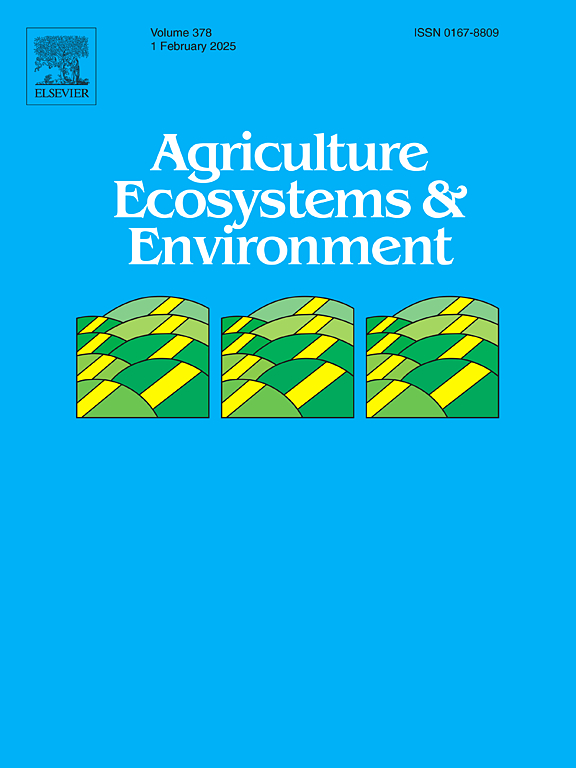高原鼠兔干扰对高寒草地土壤有机碳储量的影响与草地退化程度的关系大于与鼠兔密度的关系
IF 6.4
1区 农林科学
Q1 AGRICULTURE, MULTIDISCIPLINARY
引用次数: 0
摘要
高原鼠兔(Ochotona curzoniae)干扰对高寒草原土壤有机碳储量的影响一直存在争议。目前尚不清楚草地退化程度是否导致了这些差异。在本研究中,我们研究了不同退化程度下对照和鼠兔干扰高寒草地土壤理化性质、有机碳含量及其组分的变化。主要目的是阐明鼠兔干扰区退化程度、土壤有机碳组分和土壤有机碳储量对土壤有机碳储量的影响。结果表明:(1)鼠兔干扰使轻度(LDM)和中度(MDM)退化草地在10 ~ 45 cm范围内的有机碳含量分别增加了10.1 ~ 23.8% %和13.3 ~ 28.6 %,严重(SDM)退化草地在0 ~ 20 cm范围内的有机碳含量减少了10.1 ~ 18.3 %。结构方程模型(SEM)分析表明,草地退化程度对土壤有机碳含量的总影响是鼠兔密度的2倍以上。(ii)鼠兔干扰导致颗粒有机碳(POC)含量比矿物相关有机碳(MAOC)含量变化更大,导致其对有机碳含量的总影响更明显,尤其是在MDM中。(3)鼠兔干扰对土壤有机碳含量及其组分的影响在鼠兔洞和隧道中存在差异,在洞中以减少为主,在隧道中以减少为主。这些结果表明,鼠兔干扰对土壤有机碳储量的影响与草地退化程度的关系大于与鼠兔密度的关系。高寒草原高原鼠兔的管理策略应优先解决退化问题,而不是只注重降低鼠兔密度。本文章由计算机程序翻译,如有差异,请以英文原文为准。
Effect of plateau pika disturbance on soil organic carbon storage in alpine grasslands is more strongly associated with grasslands degradation levels than pika density
The influence of plateau pika (Ochotona curzoniae) disturbance on soil organic carbon (SOC) storage in alpine grasslands remains controversial. It is unclear whether grassland degradation levels contributed to these differences. In this study, we examined variations in soil physicochemical properties, SOC content and its components in both control and pika-disturbed alpine grasslands across varying degradation levels. The primary objective is to elucidate the contributions of degradation levels, SOC component and the extent of pika disturbed areas to the impact of pika disturbance on SOC storage. The results indicate that, (i) pika disturbance increases SOC content by 10.1–23.8 % and 13.3–28.6 % in lightly (LDM) and moderately (MDM) degraded grasslands at 10–45 cm, while decreases it by 10.1–18.3 % in severely degraded grassland (SDM) at 0–20 cm. Structural equation models (SEM) analysis suggests that, the total effect of grassland degradation levels is more than twice of pika density on SOC content. (ii) Pika disturbance induces greater changes in particulate organic carbon (POC) content compared to mineral-associated organic carbon (MAOC), resulting in a more pronounced increase in its total effects on SOC content, particularly in MDM. (iii) The impacts of pika disturbance on SOC content and its components differ between pika burrow holes and tunnels, with the decreases predominantly observed in burrow holes rather than tunnels. These findings suggest that the effects of pika disturbance on SOC storage are more strongly associated with grassland degradation levels than with pika density. The management strategies for plateau pika in alpine grasslands should prioritize addressing degradation levels over exclusively focusing on reducing pika density.
求助全文
通过发布文献求助,成功后即可免费获取论文全文。
去求助
来源期刊

Agriculture, Ecosystems & Environment
环境科学-环境科学
CiteScore
11.70
自引率
9.10%
发文量
392
审稿时长
26 days
期刊介绍:
Agriculture, Ecosystems and Environment publishes scientific articles dealing with the interface between agroecosystems and the natural environment, specifically how agriculture influences the environment and how changes in that environment impact agroecosystems. Preference is given to papers from experimental and observational research at the field, system or landscape level, from studies that enhance our understanding of processes using data-based biophysical modelling, and papers that bridge scientific disciplines and integrate knowledge. All papers should be placed in an international or wide comparative context.
 求助内容:
求助内容: 应助结果提醒方式:
应助结果提醒方式:


